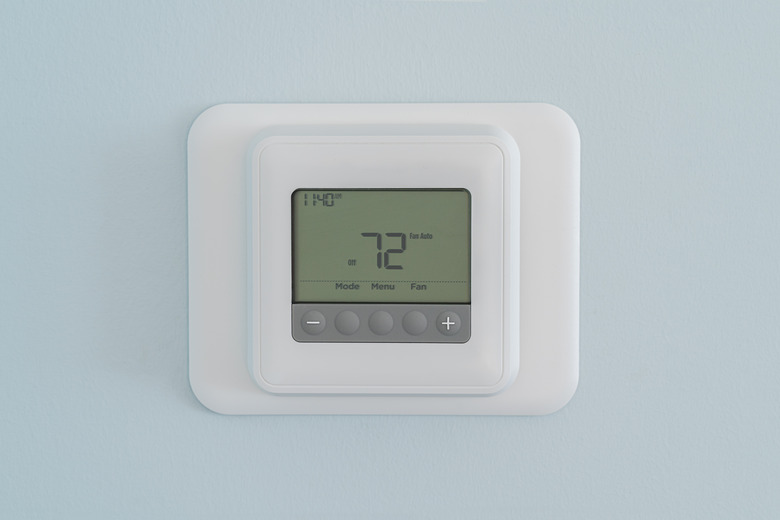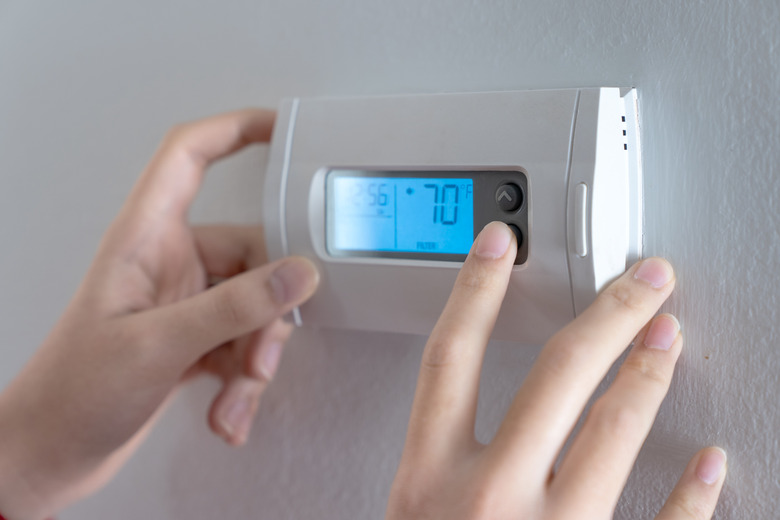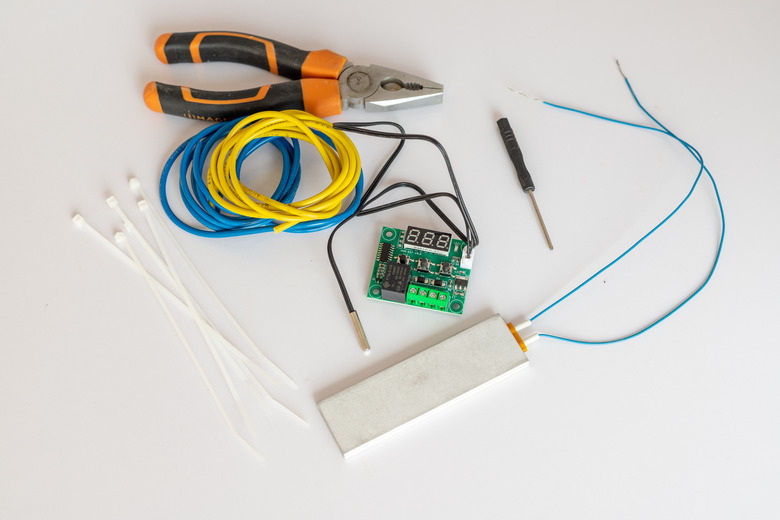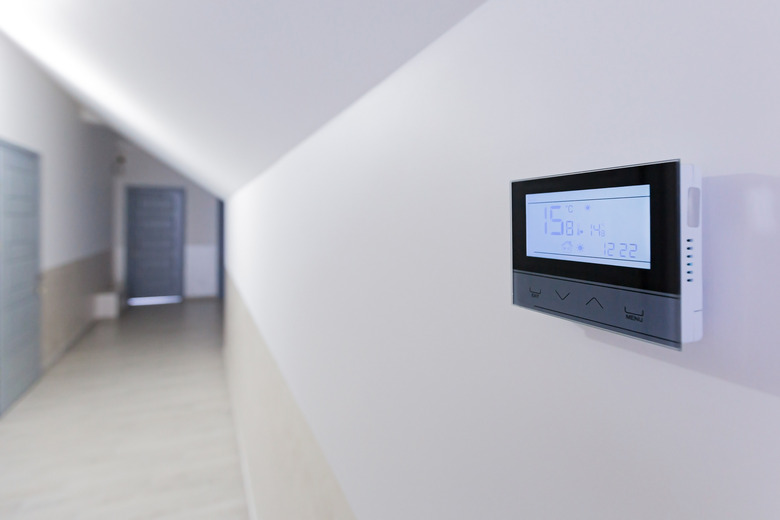How To Install And Wire A Furnace Thermostat With 2 Wires
We may receive a commission on purchases made from links.
A two-wire thermostat has limited capability compared to the four- and five-wire ones that are common these days, but it's all you really need if you want to control a furnace, wall heater, or electric baseboard heater. If you live in an older house with an analog White-Rodgers, Emerson, or Honeywell thermostat, it's a fairly simple matter to replace it with a digital thermostat or even a smart thermostat with Wi-Fi capability. The only caveat is that your new programmable thermostat must have its own power source — usually batteries — because it won't be able to draw power from the HVAC system. That requires an additional wire called a C wire, or common wire.
One important thing you need to know at the outset is whether your old thermostat is a low-voltage or line-voltage one. If it controls an electric baseboard heater, it's probably a line-voltage model, which means that the thermostat wires carry 120-volt electricity or, in some cases, 240-volt. If the thermostat controls a central heating system or cooling system, it's probably a low-voltage model that gets its power from a transformer, and it operates at 24 volts. These two types of thermostats aren't cross-compatible, so you have to know which one you have.
Here are the basics of a low-voltage two-wire thermostat and how to install one.
How a 2-Wire Thermostat Works
How a 2-Wire Thermostat Works
A thermostat is basically a switch that achieves temperature control by responding to a temperature-sensing device. In electronic models, the sensor is often a thermistor, which is a device that responds electrically to changes in temperature. The sensing device in analog models is usually a bimetal strip that responds mechanically to temperature changes, but some models contain a small vial of mercury that tips one way or the other in response to a moving coil. If your old thermostat contains mercury, you can't just throw it in the trash; contact the Thermostat Recycling Corporation for the nearest drop-off and recycling center.
Like a light switch, a two-wire thermostat has one "line" terminal for a hot wire and one "load" terminal to power a single appliance. There are no terminals to control fans, compressors, or heat pump reversing valves, which are common components of more sophisticated HVAC systems. You can use a thermostat with more than two wire terminals as a two-wire thermostat, but the reverse isn't true. If your HVAC system includes both a heating and cooling system, you need a thermostat capable of accepting more than two wires. You also need more than two wires to control a Wi-Fi thermostat, a smart home programmable model, or a learning thermostat that needs a common wire for power.
Using a Multiwire Thermostat for 2 Wires
Using a Multiwire Thermostat for 2 Wires
There's no problem with using a four-wire or five-wire thermostat to control a two-wire system; you just won't make full use of the thermostat's capabilities. A four-wire thermostat has the following terminals:
- R terminal: This is for a red wire that supplies power.
- W terminal: This is for a white wire that controls the heating system.
- G terminal: This is for a green wire that controls the blower.
- Y terminal: This is for a yellow wire that controls the compressor for the cooling system. Sometimes, a blue wire is connected to this terminal.
A five-wire terminal has an extra terminal — the C terminal — for a common wire. This wire powers features in the thermostat itself, such as the LED screen or a Wi-Fi function that connects to a home assistant like Amazon Alexa. There are two possible wire colors for the common wire: blue and black. The common wire is usually blue, and when it's black, it's because the blue wire is being used for cooling.
When doing thermostat wiring with two wires, you'll always connect the red wire to the R terminal. The choice of terminal for the other wire depends on its color and what it controls. If it's white, it probably controls the heater, and if so, it goes on the W terminal. If the wire is yellow, it likely controls an air conditioner and should go on the Y terminal. If your system consists of just a fan (a swamp cooler might qualify, but check with an HVAC pro or electrician), you might have a green wire that you can connect to the G terminal.
Things Needed
-
Mobile device
-
Batteries
How to Do Furnace Thermostat Wiring With 2 Wires
How to Do Furnace Thermostat Wiring With 2 Wires
Follow these steps to replace an old two-wire thermostat with a new two-wire model. Note: This procedure is for low-voltage (not line voltage) thermostats only.
1. Turn Off the Power
Locate the circuit breaker in the main electrical panel (breaker box) that controls the heating system, and turn it off. This is mostly a precaution if you're replacing a low-voltage thermostat because 24 volts isn't enough to give you a serious shock. It's a necessity if you're replacing a line-voltage thermostat because a 120-volt shock can seriously injure you.
2. Disconnect and Remove the Existing Thermostat
Remove the thermostat cover (it usually pulls straight off or pivots upward from the bottom) to reveal the thermostat terminals. You'll probably see a red wire connected to one terminal and a white wire to the other. Loosen the terminal screws and remove the red and white wires from the terminals. Remove the screws holding the base plate to the wall, and carefully pull the plate away from the wall, letting the wires slide through the hole in the back of the plate — do not let the wires slip inside the wall.
Tip
Some pros prefer to unscrew and remove the base plate before loosening the thermostat wires as added insurance against having them fall into the wall. Before loosening each wire connection, you might want to take a picture of the configuration with your mobile device, but there are only two wires, so it should be easy to keep track of which one goes on which terminal.
3. Attach the Base Plate of the New Thermostat to the Wall
Hold the base plate in position against the wall and level it. Some models have a built-in level, but if yours doesn't, use a torpedo level. Mark the screw holes on the wall, remove the base plate, and drill a hole on each mark large enough for a conical wall anchor. Tap in the anchors, feed the thermostat wires through the hole in the base plate, set the plate back in position, and secure it with the provided screws. Double-check the level before you tighten the screws all the way.
4. Connect the Wires
Connect the red thermostat wire to the R terminal. Many thermostats have an RH terminal for a heating system and an RC terminal for a cooling system, and they are usually bonded together with a small metal clip or strap. Since you can't use the thermostat for both purposes, it's not a bad idea to remove the bonding strap and connect to either the RH (for heating) or RC (for cooling) terminal, depending on whether you're using the device for heating or cooling.
The connector may be a screw, which you can turn with a #2 Phillips screwdriver, or a plastic spring tab that you hold back while you insert the end of the wire. Connect the other wire, which is probably white, to the W terminal to control a heater or to the Y terminal to control an air conditioner.
5. Insert Batteries and Install the Cover
If the thermostat takes batteries, insert them now. The battery compartment may be on the front of the base plate or the back of the cover plate. Snap the cover onto the base plate. If the thermostat has an LED screen, it should illuminate, and if it's a touch-screen thermostat, the screen should now be active.
How to Wire a 2-Wire Thermostat to a 4-Wire System
How to Wire a 2-Wire Thermostat to a 4-Wire System
If your HVAC system has four wires, it's probably because you have both a heating system, such as a furnace, and an air conditioning system as well as a blower to circulate the air. If this is true and the thermostat wires follow the standard color code, you'll have a red, green, white, and yellow or blue wire. Before replacing the old thermostat with a two-wire model, confirm the wiring connections at the control panel on the furnace or cooling unit so you know what each wire controls.
The red wire supplies power and must be connected to the R terminal on the thermostat. When it comes to the other three wires, you will have to choose whether you want to control a heating system or a cooling system because the new two-wire thermostat can't do both:
- To control heating, use the white wire.
- To control cooling, use the yellow wire.
- To make the blower fan come on at the same time as the heating or cooling unit, twist the G wire together with the one you're connecting (white or yellow) before connecting the twisted pair to the thermostat.
- Wrap electrical tape around the end of each unused wire, to prevent any possibility of a short circuit.



